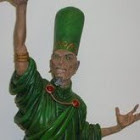 A very engaging and enjoyable collection of pieces that cover a wide range of topics. Alan Bennett refers to the book in his introduction as an album, a collection on unrelated written pieces that are collected under various headings. The lack of a unifying theme makes this large book easier to read, there is no necessity for the reader to maintain any continuity when reading the sections, they each stand for themselves. Whatever the topic, they range from an autobiographical piece about his parents and a piece of hidden family history, lectures on painting, extracts from his dairies and a wonderful dramatic monologue, the consistent aspect is the voice of the author.
A very engaging and enjoyable collection of pieces that cover a wide range of topics. Alan Bennett refers to the book in his introduction as an album, a collection on unrelated written pieces that are collected under various headings. The lack of a unifying theme makes this large book easier to read, there is no necessity for the reader to maintain any continuity when reading the sections, they each stand for themselves. Whatever the topic, they range from an autobiographical piece about his parents and a piece of hidden family history, lectures on painting, extracts from his dairies and a wonderful dramatic monologue, the consistent aspect is the voice of the author.While this could be a problem in the monologue in which the speaker is an elderly woman in a nursing home, reading it in the middle of other items shows the depth of Alan Bennett's talents as a writer. The character emerges vividly from the words, the woman is old but in no way feeble and at the same time very clearly an Alan Bennett character.
The same is true of all the pieces in the book, in particular the autobiographical pieces, Alan Bennett explores Alan Bennett the character with the same care and attention to detail as the writer devotes to his fictional characters in his plays. This is a really good thing, no one's life is really interesting to anyone else, in an unedited, unformed shape it is just a series of mundane events more or less interrupted by something that can be packaged up for the interest of others. The difference is the skill with which it is packaged and in this volume Alan Bennett displays a rare and astonishing skill.
The portrait of his parents is both heartfelt, unblinking and deeply sympathetic to people who would have squirmed at the attention. The details of his mothers steady loss of personality but not physical health and the significantly messy reactions it creates are thankfully not undermined by guilt or structural demands for sympathy from the reader. By casting himself as a character, the writer can develop a required distance from the events to capture the tangle without loosing sight of the fact that the reader is in fact a stranger.
This is true also for the piece about being diagnosed with cancer and his struggle not only to live with it but to manage the eternal aspect of living with cancer without becoming a victim of cancer. The dynamic struggle between an innate reticence and the push for communication inherent in being a writer is nicely made explicit.
The tone of the pieces, including the lectures on delivered as a Trustee of the National Gallery in London is conversational. Alan Bennett is emphatically talking directly to the the reader in his own voice, they are all monologues delivered by a master of the art. The pieces rarely follow a straight line, they turn and wander and return as a conversation might as the performer tries to maintain the interest and attention of the audience. Alan Bennett is conscious that he is requesting something very valuable from the reader, time and attention, and lacking a clear dramatic structure and pay off to reward this has to do so another way. The superbly constructed pieces draw in the reader and reward the time and attention with strong, considered views, excellent jokes and interesting company from a man who is interested in others.


No comments:
Post a Comment